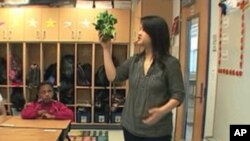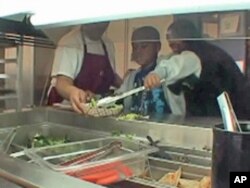An elementary school in Washington, D.C., has launched an innovative program to provide a more healthful food culture for its students.
In a third grade mathematics class at E.W. Stokes Public Charter School, 8- and 9-year-old students are learning a basic math concept; how to create combinations, which in this case includes items like spinach and eggplant.
"We just incorporated food into different types of combinations," says their teacher, Hannah Chen. "Like with the pizza, they had two types of toppings that the kids can provide and figuring out the different combinations using those toppings."
This year the school started a special program to weave food topics into its third-grade math and English curricula. Designed in partnership with Seedling Projects, a non-profit environmental group based in San Francisco, California, the program is called Farm to Desk.
"We are actually doing this in part to address the issue of childhood obesity," says Peter Nalli, a Farm to Desk curriculum director. "One of the main components of our program is our belief that if kids are exposed to positive and healthy messaging about food throughout the instructional day, that has the most potential to impact long-term change."
According to the U.S. Centers for Disease Control and Prevention, the rate of childhood obesity in the United States has tripled during the past 30 years. One in five children between the ages of six and 19 are now considered overweight. A recent study at the University of California, Berkeley found that the more kids are exposed to discussion of food topics and food vocabularies, the more likely they are to make better nutritional choices.
The Farm to Desk program has three parts: a curricular component where teachers use food content in classes, a garden where the kids participate in planting and harvesting and a cafeteria which prepares and serves wholesome, nutritious meals.
"Everything we do here is from scratch," says Makeisha Daye, a school chef. "They are getting food like they are at home. And for those that do not get it at home, we make sure they receive it here."
Daye says the school purchases most of its food ingredients from local sustainable farms, but also gets some of its fresh produce from the school garden, which is tended by students.
"They are replanting everything now so that we will be using fresh herbs, fresh vegetables straight from our garden. The children, they love it."
Back in the classroom, Asia Simms selects chicken and tomatoes as the topics for her combination exercise. She says those are her favorite burrito ingredients, wrapped inside corn-flour tortillas.
"I think it is fun," says Asia. "I like it because I get to learn what is good to eat."
Her teacher sees that the effort is making a difference.
"It is a great, positive impact," says Chen. "Like when they go to lunch they always pick healthy options. We have a salad bar at school. Now the kids love the salad bar. They love the fruits and vegetables. So I think it is making a big difference in their life."
The children are now looking at the nutrition labels on food packages to read how much sugar or fat each contains. Farm to Desk has been such a success with the third-graders, that the school is planning to expand the program to other grades next year.


